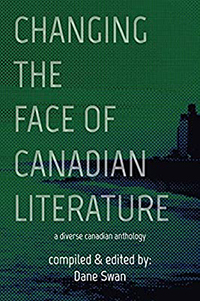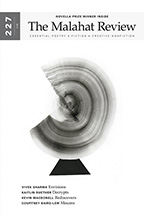Reviews
Fiction, Poetry, & Nonfiction Review by Dennis L.M. Lewis
Dane Swan, editor, Changing the Face of Canadian Literature: A Diverse Canadian Anthology (Toronto: Guernica Editions, 2020). Paperbound, 395 pp., $25.
 Changing the Face of Canadian Literature is an anthology of new and recent writing by a diverse range of Canadian writers. The editor,
Changing the Face of Canadian Literature is an anthology of new and recent writing by a diverse range of Canadian writers. The editor,
Dane Swan, places the notion of diversity front and centre: “this anthology does not celebrate multiculturalism, it celebrates diversity.
Diversity is a far wider spectrum. Diversity recognizes those franchised and disenfranchised.… the geography of Canada.… that new writing can be written by the young and the young at heart.… that an author may identify as male, female, or other.…” Swan’s sentiments are laudable, but some readers may wish that he had mapped out a more convincingly grounded argument for the principle of diversification and made a case for a fuller understanding of the possibilities that diversity makes available for Canadian literature. In any case, most of the writers in this collection, which usefully spans poetry, short stories, and nonfiction, are non-mainstream: that is, of non-white
ethnic heritage and of diverse sexuality. Indeed, identity seems a central preoccupation for many of them, and the diverse range of genres, forms, and voices makes this an exciting, if uneven, and frequently pleasantly surprising collection.
Rather than separate the contributions by genre, Dane wisely allows poetry to abut with stories, essays, and work that skirts all of these genres, so that what we get is a diverting, multi-voiced conversation between forms, genres, and the different regions of Canada. In the story “Kabloona Red,” for example, the Inuit writer Norma Dunning explores trauma from sexual abuse and racism, alcoholism, and the frustrations of living in a remote area. In excerpts from his School for the Deaf, Adam Pottle explores what he terms “the fiery beauty of Deafness and disability” in poems filled with startling imagery that are impressively transformative. Pamela Mordecai’s excerpts from The Tear Well, a story apparently set in Jamaica, are another highpoint. Her characterizations in this story of an abusive marriage and the impact it has upon the couple’s children and the wider family go beyond stereotypes
of Caribbean life as well as the all-too-easy Manichean dichotomies between good victims and bad oppressors. The images of Jamaican masculinity are revealed as the fascinating, mysterious object of Mordecai’s attention, and are therefore also ours as readers.
To his credit, Swan has included a broad range of different types of poetry, going beyond print into performance art and spoken poetry. In some respects, though, spoken-word poetry is at a slight disadvantage here. What is illuminating and powerful in a live spoken-word performance can often appear flat on the page, particularly alongside more formalized poems. This is unfortunately the case with the work of the spoken-word poet Dwayne Morgan and the performance poet Jamaal Jackson Rogers. The latter’s two poems do not quite do justice to his reputation as an award-winning Poet Laureate, while of Morgan’s three poems in this anthology, “Colin K” is the most impressive. It presents a diatribe and chronology of events dating from NFL quarterback Colin Kaepernick’s decision to kneel during the playing of the U.S. national anthem in protest against police brutality against Black Americans. The poem’s diatribe, its roll call of the names of African Americans murdered by the police, and its denunciation of corporate America’s contempt for Black people give the poem its up-to-the-minute relevance. Tragically, this poem seems evergreen.
As noted, many of the works here are concerned with identity. National identity, colonialism, and racism feature in Kaie Kellough’s story “Capital.” The narrator and his girlfriend visit the National Gallery in Ottawa, where they appraise the famous “Death of General Wolfe” painting and discuss Canadian art. This story exposes the
contradictions, tensions, and ambiguities of the current cultural moment. Yet the story also seems to be interrogating its own proclivities: “I turned away from the view of the frozen canal, of Parliament Hill rising in the distance, the age of its buildings comforting yet disturbingly permanent.” Ashley Hynd’s poetry focuses on her Indigenous identity and the history of Canada’s and the U.S.’s eradication of her Indigenous culture. Her poems turn language and everyday artefacts into ironical and, at times, gently self-mocking meditations on Indigenous history. In “a spoonful of sugar (makes the medicine go down),” she turns her great-grandmother’s jumbled memory and mispronunciation of Custer’s name into a wry observation on the cruel
irony of history. This prose poem’s meaning is amplified by the reader’s repetition of the common saying in the poem’s title: “Sitting Bull and Tecumseh where [sic] both there the day that Custard died guess that’s the problem when you add cream to your coffee—it gets too white—stops being coffee starts being cream.”
Other forms of identity also receive attention. Queer identity is the determinative factor in the multi-disciplinary artist Charlie Petch’s poems. “My First Boyfriend” and “Daughter of Geppetto” address the specifics of their experience while also making that experience speak to broader issues of human identity and presence: “I remember the boy you might have been / smell sumac carefully. / Did you know it
was poison then? / That enemies can smell sweet? / That betrayal is part of growing up?” In Mary Pinkoski’s poetic suite, “Let the Ghosts Out,” her touchstones are talismanic women writers (Anaïs Nin, Tara Hardy, Anne Waldman) and her focus is on embodiment and presence as experienced by women: “We are nothing more than dilapidated shelters / Seeking small mercies / Like a sparrow choosing to nest in our branches.” This evocation of a unique embodiment for women’s history and cultural experience is an interesting and potentially controversial one now, when such claims are being increasingly challenged by the discourse around transgender and non-binary identities.
Besides those noted, the anthology has other standouts. Sara Tilley’s story “Crystal,” for example, relates a breakdown of a relationship with a distinctively magical-realist feel: Carrie’s Phantom Baby, linked by its umbilical cord to her wrist and floating buildings-high into the sky, accompanies Carrie on her journey across Canada as she
tries to get over her breakup. It is subtle, masterful storytelling that transforms the familiar and quotidian into something breathtaking. Doyali Islam’s poem “she” is another high point. I don’t know much about “la famille faisons” that she dedicates the poem to, but I don’t have to, so assured is Islam’s control of diction and form and her succinct evocation of the characters and narrative. The poem describes a family who’ve chosen to live what they deem to be a more authentic life in nature, without modern amenities: “she is a stern woman whose cheeks rarely betray / a fissured smile, she followed / her merry brown-beard of a husband / into apex’d wilderness.…” Inevitably, nature wins: “a falcon prowls overhead, and / black ants march inside the breadbox, and / on the kitchen counter, claim undefended / blonvilliers brown sugar cubes as their own.”
Leslie Shimotakahara’s story “The Breakwater” is yet another high point, a poignant account of the aftermath of a family’s estrangement against the background of the forced internment of Japanese Canadians during wwii. The protagonist must reckon with his troubled relationship with his rebellious brother, and the story is a study of filial resentment, jealousy, failure, and finally familial responsibility. The story’s power lies as much in what it does not explicitly state as what it does and in its restraint and mature response to life’s complexities.
Michael Fraser’s five poems represent another triumph. Each is formally accomplished, intelligent, and strikingly original. “The Black Union Dead” depicts its speaker and a colleague burying dead soldiers after a U.S. Civil War battle. The breathtaking opening, with its striking diction and rhythmic metered pulse, jolts the reader into that horrific world: “The sun-shattered morning sieves / through bottom-lands clapping cadavers / rippled under the tree’s tea-green antlers. / Me and Abel crumble low, / hinge and shoulder remains from / the Tennessee’s mud-soaked banks.” “Grand Junction,” another impressive evocation of the Civil War, features a slightly unfamiliar and archaic, yet somehow more primal form of regional English—“copperhead,” “pig sticker,” “pipjennies,” “livermush,” “gray backinfected,” “top-rail sawbones”—full of compound nouns, stressed vowels, and clashing consonants evocative not only of the time and the place, but also of the very act of war itself.
The anthology ends strongly with the work of the Montreal-based poet Klara du Plessis. Evidently of Dutch descent—“Quidditief” is written in Dutch, then translated into English—she addresses a broad range of concerns here: the nature of being, the meanings latent in artefacts, the inherent nature of things, and the grammar of art. The poems are allusive, subtle, self-conscious, yet confident in diction and tone. “To the woodcut above my writing desk” is an impressive update on the ekphrastic poem, where woodcuts evoke such a variety of scenes in her imagination that it seems as if they’re interrogating poet and poem. The poem’s reflective momentum, however, propels the reader outward to the reader’s own existence projecting onto the
present moment: “A fault line surfaces and plunges / into the crisp details of its own potential for plunder / … Shoot from the hip. / Project a collective haemorrhage into the soft expanse / of the present.” It’s an oddly jarring conclusion. It strikes me as much an invitation and challenge as a condemnation. Shooting from the hip. In du Plessis’s reckoning, imposing one’s own personal tincture onto the expansive, still-evolving project we call Canada seems to be an act of plunder and desecration, but, at the same time, the act of allowing ourselves to become absorbed within its immensity, becoming something other, strikes me as courageous and self-defining.
In any case, du Plessis’s poem gestures towards the violence—racialized, gendered, sexualized, and colonial, past or present—that is a central concern of many of the authors, and their work jointly and individually raises questions about literature’s relation to the complex historical and social worlds from which it emerges and in which it circulates. The recent protests and racial accounting in the U.S. and Canada in the wake of a cop’s murder of George Floyd have sparked a renewed interest in the work of the African American writer James Baldwin. His example is relevant because in his searing essays, novels, and drama, he expresses his anger through his art, speaking trenchant truth to power about the very real racist aggression experienced by Black Americans without reducing his art to incidental accounts of hatred and resentful outbursts. In the last essay of The Price of the Ticket, he goes so far as to say that “The object of one’s hatred is never, alas, conveniently outside but is seated in one’s lap, stirring in one’s bowels—and dictating the beat of one’s heart. And if one does not know this, one risks becoming an imitation—and, therefore, a continuation—of principles one imagines oneself to despise.” As the quotations above show, much of the work in this anthology—based on a poetics of diversity—seems aware of the perils of writing out of a predetermined antagonism towards mainstream culture that might foreclose meaningful dialogue with different visions of Canada. It’s the necessary challenge that writers from diverse backgrounds must accept if they truly want to enter and help shape this nation’s literary and cultural currents.
—Dennis L.M. Lewis









